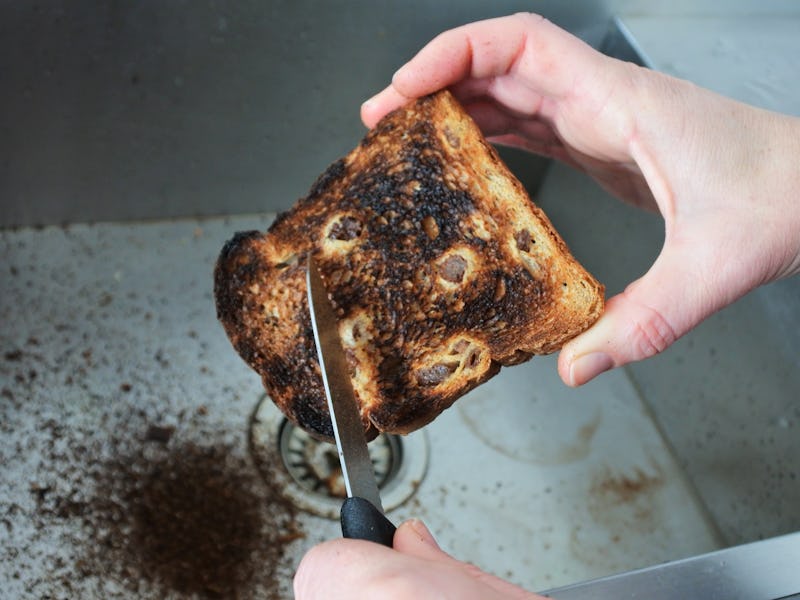When it comes to toast, should you go for the gold?
Plus: A ketamine discovery offers more suggestions for its powers to fight depression.

We’re going to debunk a food myth and offer more evidence of the depression-crushing wonders of ketamine. Our weight lighting columnist mixes cultural observation with tips for building upper-body strength. Finally, we revisit a NASA anniversary from 50 years ago.
It’s a variety of stories that all serve a unifying goal: To make you a little more thoughtful about yourself and your world. It can only mean you’re reading Inverse Daily. I’m Nick Lucchesi. Thanks for being with us.
This is an adapted version of the Inverse Daily newsletter for Tuesday, November 16, 2021. Subscribe for free and earn rewards for reading every day in your inbox. ✉️
Go for the gold?
[By Sarah Wells]
It’s the crispy, forbidden crunch of an overtoasted marshmallow or the acrid mouthfeel of blackened toast smothered in jam.
Whether a culinary accident or an exercise in digestive boundary-pushing, it’s no surprise that we’ve all eaten our fair share of burnt foods. But is this relaxed approach to food safety as harmless as you think?
Maybe you’ve heard eating burnt food can make you sick. Or maybe, after a quick Google, you’ve read blogs that claim that eating burnt food — from slightly blackened barbeque to scorched toast — will fill your body with cancer-causing carcinogens.
In 2017, the U.K.’s Food Standard Agency even launched a campaign against the consumption of darkened food, telling diners to “Go for Gold” with their food’s color instead.
Related:
A ketamine discovery
[By Sarah Sloat]
While antidepressants can provide some relief, two significant hurdles keep them from helping everyone with major depressive disorder (MDD).
One is that some people experience what’s called treatment-resistant depression. Because approximately 30 percent of people with MDD fail to respond to antidepressants, scientists are working toward tweaking the application of serotonin uptake inhibitors (SSRIs) and finding new, more effective therapeutics.
The other issue is it can take several weeks for traditional antidepressants, like SSRIs, to show an effect. This therapeutic delay is especially an issue for individuals at risk for suicide.
This is in part why researchers are so interested in the potential of ketamine. Officially a legal anesthetic, a growing body of research suggests ketamine also induces antidepressant effects. Most critically, ketamine is a “rapid” antidepressant.
Related:
Upper body strength
[By Sam Reiss]
Lately, there’s been a tendency in fitness to look past the upper body and focus down on the legs and the posterior chain.
It’s a recent one. In the before times — say, 2006 — folks might program leg day twice a week and skip it half the time. But things have changed.
In the past decade or so, functional powerlifting routines have taken over to tax our legs and posterior chains daily. Leg day has become most of the week.
Programming has improved. Which makes sense: lots of information is free, our quads are our biggest muscles, a healthy back is needed for good posture, and squats are the best exercise in the world. But does all this leg day observation ignore upper body strength? What functional purpose does strengthening our upper bodies — our backs, shoulders, and arms serve? And how should we do it?
Related:
Martian volcanoes
[By Jon Kelvey]
You have to feel for Mariner 9. First, the spacecraft loses its twin, Mariner 8, in a launch failure just weeks before Mariner 9 was scheduled to blast off toward Mars on May 30, 1971. Not only would Mariner 9 travel to the Red Planet alone, but it would also do the work of two space probes.
Fifty years ago, on November 13, 1971, Mariner 9 became the first spacecraft ever to enter orbit around another planet. It gets its cameras ready, points them at the Martian surface, and sees … nothing but fuzz. A global dust storm obscures the entirety of the planet’s surface features.
But hey, no problem. Mariner 9 is a robot without feelings and with infinite patience — plus a reprogrammable computer. It can bide its time until finally taking its place as the crown jewel and penultimate mission of the Mariner planetary exploration program — the mission that first introduced us to the Mars we know today.
Related:
A brown bear walks along an oil-covered beach in Alaska after the Exxon Valdez oil spill in 1989.
- About the newsletter: Do you think it can be improved? Have a story idea? Want to share a story about the time you met an astronaut? Send those thoughts and more to newsletter@inverse.com.
- On this Day: On November 16, 1973, President Richard Nixon approved the construction of the Trans-Alaska Pipeline. By early 1980, the 34-inch pipeline had moved one billion barrels’ worth of oil from Prudhoe Bay in the northern reaches of the state down some 800 miles to the Valdez harbor, where it would be put on tanker ships and carried to California. (Oil was discovered in Northern Alaska in 1968, which spurred the construction of the pipeline.) More than 267,000 gallons of oil spilled onto the tundra in March 2006, after the BP Prudhoe Bay facility saw one of its transit pipes rupture from corrosion. The spill had gone undetected by managers for days. The largest spill associated with the pipeline is the 1989 Exxon Valdez oil tanker spill at the southern end of the pipeline. More than 11 million gallons were spilled into Prince William Sound. Images of the oil-slicked environment and its wildlife were seen around the world. One of those images is above.
- Song of the Day: “The Price of Gasoline” by Bloc Party